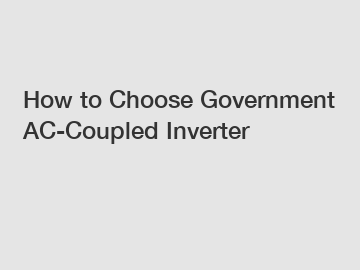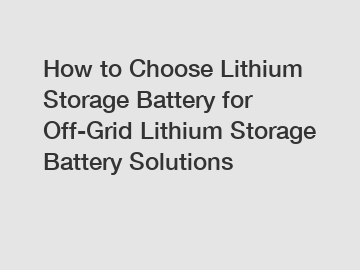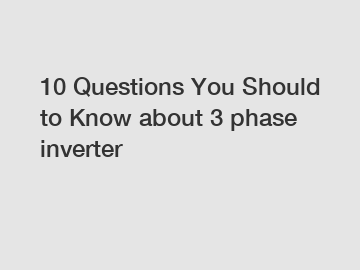10 Things You Must Know About Lithium Ion Battery Configuration
Jul. 15, 2024
10 Things You Must Know About Lithium Ion Battery Configuration.
The popularity of lithium-ion batteries has grown exponentially over the years, becoming the preferred power source for various electronic devices such as smartphones, laptops, and electric vehicles. In this article, we'll go over ten essential things you should know about lithium-ion battery configuration.
1. Lithium-Ion Batteries Come in Different Shapes and Sizes.
Lithium-ion batteries come in different shapes and sizes, depending on the application. For mobile devices and laptops, the most commonly used type is a flat, rectangular-shaped battery. On the other hand, cylindrical batteries are often used in power tools, e-cigarettes, and small home appliances. Meanwhile, for electric vehicles, large battery packs usually consist of several thousand small, rectangular batteries.
2. Voltage and Capacity Varies.
Lithium-ion batteries come in different voltage and capacity ratings. Voltage is the electrical potential difference between the positive and negative terminals of a battery, whereas capacity refers to the amount of energy the battery can store. The most commonly used voltage ratings are 3.6V and 3.7V, while battery capacities range from 500mAh to 8000mAh.
3. The Number of Cells Determines Voltage and Capacity.
A single lithium-ion cell has a voltage of around 3.6V, but by connecting multiple cells in series, the voltage rating increases. For instance, a two-cell lithium-ion battery pack would have a voltage rating of 7.2V, while a four-cell battery would have 14.4V. On the other hand, connecting cells in parallel increases the capacity rating without changing the voltage.
4. Cell Balancing is Important.
In a lithium-ion battery pack with multiple cells, cell balancing ensures that all the cells discharge and charge equally, prolonging the battery's life. By balancing the cells, the voltage and capacity of each cell are matched, preventing certain cells from being overcharged, which can lead to swelling and, in severe cases, explosion.
5. The Battery Management System Controls the Performance.
Lithium-ion battery packs have a battery management system (BMS) that regulates the battery's performance, monitoring the voltage, temperature, and state of charge (SOC). The BMS also prevents the battery from overcharging, over-discharging, or overheating, ensuring the battery's safety and performance.
Additional reading:What are the disadvantages of string inverters?
Industrial Solar: Are String Inverters the Future?
Is single phase string inverter worth it?
Are Microinverters the Future of Solar Power?
Unlocking the Potential of Intelligent Three-Phase String Inverters
AC Coupled Inverter vs. DC: Which is Best for Germany?
Prismatic vs Pouch vs Cylindrical Lithium Ion Battery Cell
6. Different Lithium-Ion Chemistries Exist.
Different chemistries exist for lithium-ion batteries, each with unique characteristics, such as high energy density, long cycle life, or high output power. The most commonly used lithium-ion chemistries are Lithium Cobalt Oxide (LiCoO2), Lithium Iron Phosphate (LiFePO4), and Lithium Manganese Oxide (LiMn2O4).
7. Charging and Discharging Affects Battery Life.
The battery's lifespan is affected by how often it's charged and discharged. Lithium-ion batteries have a limited lifespan of around 500 to 1000 charge cycles, after which the capacity drops significantly. Fast charging and deep discharging also reduce the battery life, so it's essential to use the battery according to the manufacturer's recommendations.
8. Temperature Affects Battery Performance.
A lithium-ion battery's performance is affected by temperature, with optimal performance at around 20 to 25°C. High temperatures can cause the battery to degrade faster, reducing the battery's life. On the other hand, very low temperatures can affect the battery's capacity and voltage output.
9. Safety Precautions are Important.
Lithium-ion batteries can be dangerous if not handled correctly, and safety precautions should always be taken. Some safety precautions include not puncturing or damaging the battery, not exposing it to very high or low temperatures, and not charging it with unapproved chargers.
10. Recycling is Important.
Lithium-ion batteries contain hazardous materials such as lithium and cobalt, which can harm the environment if not disposed of correctly. Recycling the battery ensures that these materials are safely disposed of, reducing the impact on the environment.
In conclusion, lithium-ion batteries are an indispensable part of modern life, powering a wide range of electronic devices. Understanding their configuration is crucial to ensuring their longevity, performance, and safety. By following the ten things we've discussed in this article, you can get the most out of your lithium-ion battery.
If you want to learn more, please visit our website lithium ion battery configuration, 100Ah Li ion Prismatic Cell China, Prismatic lithium cells Bulk order.
Additional reading:The Future of Lithium Storage Batteries: Size Matters
How does a government ac-coupled inverter work?
The best lithium battery
2 Pack 3000mAh P102 Battery Replacement ...
Choose the Best Lithium Solar Battery in South Africa
What is the downside to string inverters?
What are the Key Questions to Ask When Ordering a User-friendly Single Phase String Inverter?
46
0
0
Related Articles










Comments
All Comments (0)